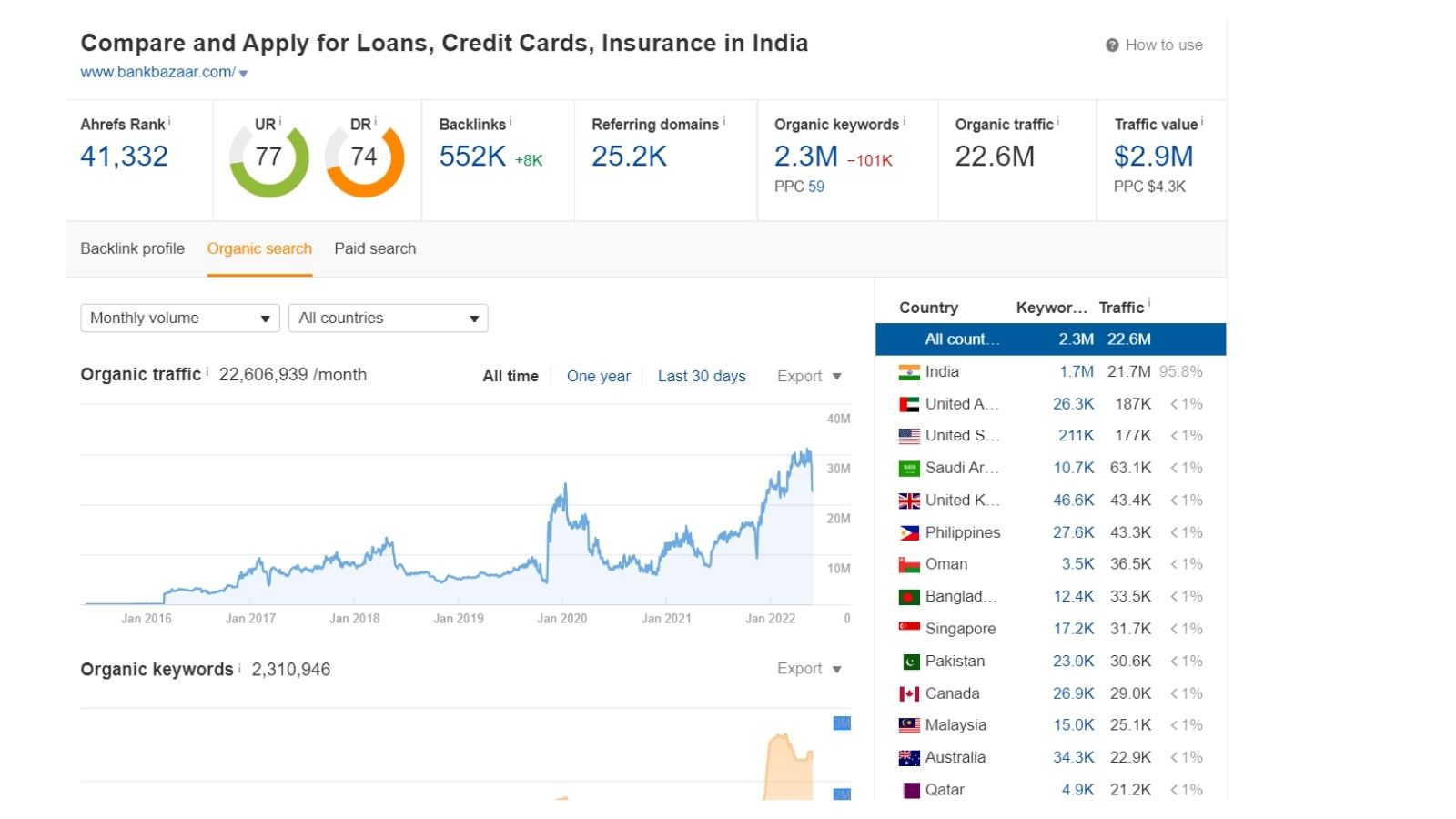Amazon-backed BankBazaar is one of the rare startups that have stood the test of time!
Founded in 2008, during the financial crisis, this fintech company
- now makes INR 156 crores in revenue
- boosted its credit card issuances by 82% in FY22 to 50M
- has turned profitable in March 2022 by cutting its operation costs
- and, is eyeing an IPO in 2023!
But, startups need an ACE marketing strategy to grow as quickly as BankBazaar has. In the case of BankBazaar, SEO is that ACE in their arsenal.
More importantly, BankBazaar employs a clever SEO strategy that doesn't require them to write tons of content, and still gets them millions of users!
So let's break down BankBazaar's SEO strategy, and steal it for ourselves 😎
Firstly, what does BankBazaar do?
Well, BankBazaar is basically an online marketplace for financial products.
If you are looking for an ideal insurance policy, home loan, car loan, or savings plan, BankBazaar is the platform for you. You can easily compare all the different options to find the best policy for you.
BankBazaar is also the largest fintech co-branded credit card issuer. And, its 500M registered users can easily check their credit scores on the website.
So, any adult looking for financial products online is a target customer for BankBazaar. But, how do they reach these customers?
Well, one of their major traffic sources is SEO. Let's look at how they are doing on that front.
So, how is BankBazaar doing SEO-wise?
BankBazaar is doing incredibly well when it comes to SEO!
- It gets 22.6M organic traffic every month!
- And, ranks for 2.3M keywords. Among these, the majority are non-branded keywords.
- BankBazaar has acquired 552K backlinks and has a DR of 74
What's impressive is that it easily ranks for high volume keywords like:
- encumbrance certificate — 201K/month
- credit score — 200K/month
- how to link pan card with aadhar card — 49K/month
And, if you were to simply search "car loan", "home loan", etc on Google, you will definitely come across BankBazaar's page in the results.
So, BankBazaar has successfully figured out a way to get relevant traffic to its website. But, how is it able to get ~22M visits each month?
Well, to break down BankBazaar's exact SEO strategy, let's start by investigating its top pages.

Let's investigate BankBazaar's top subfolders!
BankBazaar's traffic is distributed quite uniformly throughout its many subfolders as you can see below.
But, the top 4 sub-folders that contribute most of the traffic are as follows:
.jpg)
- bankbazaar.com/indian-holiday — 2.3M traffic
- bankbazaar.com/tax — 1.5M traffic
- bankbazaar.com/ifsc-code — 1.29M traffic
- bankbazaar.com/saving-schemes — 993K traffic
The "indian holidays" subfolder ranks for all the bank holiday related queries like "republic day 2022", "bank holidays 2021", etc.
The "tax" and "saving schemes" subfolder essentially includes blog pages that cover tax and saving scheme-related topics.
But, the IFSC code pages are unique from these traditional blogs. How? Well, let's find out!
BankBazaar's low-effort strategy to get millions of users!
The IFSC code pages land on this very simple tool that tells you the IFSC code of a particular bank's branch.
.jpg)
To give more context, the IFSC code is basically a numeric code used for bank transactions. All you have to do is enter the details about your bank like:
- The bank's name
- State it belongs to
- District
- Branch within the district
And, voila! You get all the details along with the IFSC code of that branch!
So, how does the tool work & rank for so many keywords?
At this point, it'll help to know the basics of programmatic SEO that we covered in our previous article. Put simply, BankBazaar's tool creates automated pages by fetching inputs from a fixed set of data.
Here's how the tool works:
- Every time you enter one of the details, the page reloads to a different URL. For example, first, you have to enter the name of your bank.
- If you enter "State Bank of India" as your bank, the page reloads to the SBI URL.
- URL structure ➝ www.bankbazaar.com/ifsc-code/state-bank-of-india
- Similarly, when you add the state to "Maharashtra", your URL reloads to:
- URL structure ➝ bankbazaar.com/ifsc-code/state-bank-of-india/maharashtra
- Finally, when you enter all the 4 detail, the page reloads to display the IFSC code and the branch details. Here's how the URL structure looks:
- URL structure ➝ bankbazaar.com/ifsc-code/state-bank-of-india/maharashtra/mumbai/andheri-west-branch
.jpg)
- In the final link, you can see that the URL is divided into 4 parts based on the 4 details.
- Now, you see, this allows BankBazaar to rank for thousands of keywords that are essentially different combinations of the 4 details mentioned above. These keywords could be:
- sbi ifsc code (Volume = 142K) — bankbazaar.com/ifsc-code/state-bank-of-india
- allahabad indian bank ifsc code (Volume = 3.2K) — bankbazaar.com/ifsc-code/indian-bank/uttar-pradesh/allahabad/allahabad-branch
- Based on how detailed the query is, a corresponding page shows up in the search ranking.
Great! So, what do we learn from this?
Well, BankBazaar ranks for over 80,000+ pages and 236K+ keywords for the IFSC subfolder. Collectively they get over a million visitors each month.
That's all for a simple tool that basically fetches data from a static database. Moreover, the data is evergreen! Details about bank branches rarely change so it's basically a one-time investment that reaps users for a very long time.
And, the influx of users is also mostly constant. Think about every time you enter details about your bank while making a transaction, you are bound to quickly Google the IFSC code of your branch.
Moreover, BankBazaar cleverly runs ads on these pages, bringing that extra revenue for a little to no effort!
Let's quickly summarise our key takeaways from BankBazaar's SEO strategy:
- Writing long blogs isn't the only way to get SEO traffic. You can also buildd simple tools that are useful for your audience, and get traffic by targeting what they search for daily.
- This approach of using content to buildd tools is also easily scalable! Every additional keyword you target or page you create requires minimal effort.
- You will find the need for such tools in every niche. All you need to do is to figure out what solution to your users' problems can be automated through a simple tool. It can be an IFSC code finder, retirement age calculator, business name generator, or a ton of other things.
So, go on and find what simple tool you can buildd on your website that will drive consistent SEO traffic for you!








